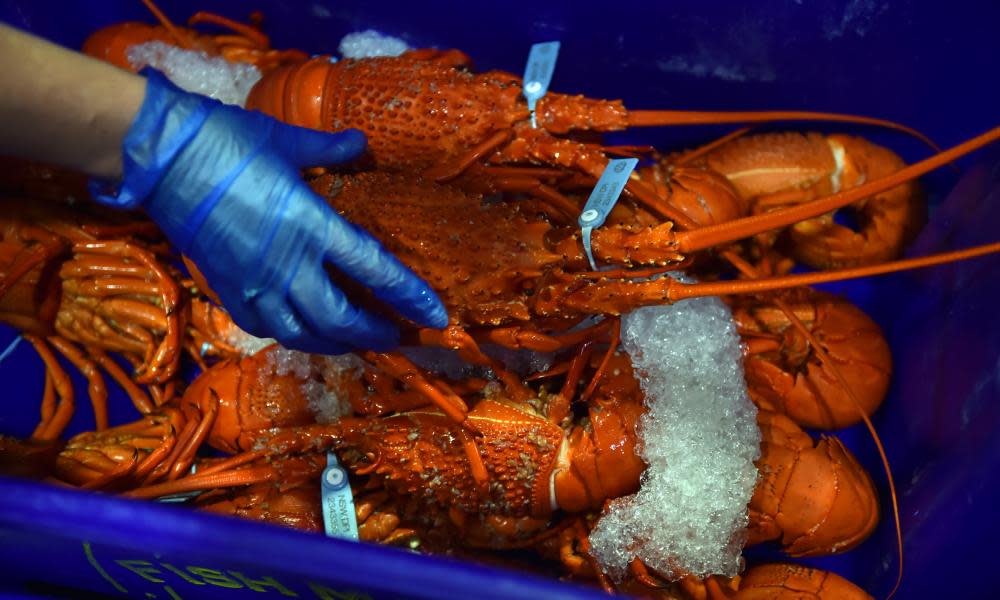'Barely a scallop': fears oil and gas exploration will destroy fisheries

There are calls for a moratorium on seismic surveys by the oil and gas industry from members of the fishing industry after new Australian research shows it has serious impacts on invertebrates such as lobster, scallop, abalone and crab.
The calls come as three different oil and gas companies have told industry bodies they want to carry out seismic explorations in the Otway basin this summer.
Tasmanian Seafood Industry Council (TSIC) chief executive, Julian Harrington, says: “This is a big issue for our industry and we now have research that backs our concerns.”
The three companies that want to survey the Otway basin area, south of Victoria and west of King Island, are Schlumberger Australia, 3D Oil and SpectrumGeo. A fourth, CGG, is looking to the east in the Gippsland basin. All four have indicated potential start dates in October and November.
John Samson, chief executive of the Tasmanian Rock Lobster Fishermen’s Association, says: “Some of my members would just want [the seismic surveyors] to stop”, adding some wanted a federal court injunction to block the surveys.
In the past 12 months, Australian scientists have published research on the impacts of seismic surveys on invertebrates.
The research has found that seismic air guns, used around the world to search oceans for fossil fuels, affect the immune systems of lobsters, are correlated with increased rates of mortality of scallops and kill zooplankton at a range of about 1km from the air gun.
“That research published in high level publications really shed a new light and gave a peer reviewed scientific evidence base that supported a lot of our anecdotal concerns,” Harrington says.
“There are a lot of question marks around the impact of seismic [surveys] on larvae of our key commercial species,” he says, adding his industry wants “a better collaborative arrangement” with the oil and gas industry.
Harrington says proposals from 3D Oil and SpectrumGeo overlap rock lobster and giant crab areas. There are also concerns about cumulative impacts from multiple surveys.
“There has been a long-held view among fishermen worldwide that seismic activity does impact target species for the seafood industry,” he says.
Johnathan Davey, the chief executive of Seafood Industry Victoria, is alarmed companies want to start work in only a few weeks when some have not submitted an environmental plan to the National Offshore Petroleum Safety and Environmental Management Authority (Nopsema).
He says: “These companies have to show they are undertaking work that’s going to have as low as is practicable impact on the marine environment. But how do you demonstrate that with a lack of science and information?”
Davey says the Gippsland basin survey was in a region previously known as the “number one fishing ground for scallops in Australia” but “since 2010, when the first seismic survey was taken, there has barely been a scallop industry in that area.”
He says abalone, lobster and scallop have “a free swimming larval stage” which, if impacted, could see catches drop “five to seven years down the track.”
Greens senator Peter Whish-Wilson wants a Senate inquiry into seismic testing. Davey, Samson and Harrington all say they would support an inquiry.
Associate professor Robert McCauley, of Curtin University, was involved in the studies on zooplankton, scallops and lobster, and say fishers are “wise to be concerned.”
“From a scientific point of view, we don’t know [about impacts on larvae] but looking at the other studies you would say late-stage larvae would be susceptible to being killed by air gun signals,” he says.
Associate professor Jayson Semmens, of the University of Tasmania’s Institute for Marine and Antarctic Studies, says: “We are in a knowledge vacuum but so far with all the groups we have looked at – both the adults and the plankton – there have been impacts.”
Semmens says the tiny larvae of rock lobsters and other invertebrates float in the ocean for up to two years as they mature and the results of other studies suggest there is a risk they could be impacted by seismic surveys.
“If you affect those stages, then that’s a big issue,” he says.
Matthew Doman, external affairs director at the Australian Petroleum Production and Exploration Association, says seismic surveys are “low risk, well understood technology”. He says the Gippsland and Otway basins have seen more than 170 seismic surveys since the 1960s with “no negative impact on a commercial fishery, nor an impact on the viability of marine species or marine ecosystems.”
According to Doman, the industry is the biggest non-government funder of marine research and supports work on how seismic surveys “may affect marine life”.
Doman describes several perceived issues with the invertebrate studies and warns against “considering them in isolation”.
Noel Newman, executive chairman of Melbourne-based 3D Oil, says: “We take our environmental responsibilities and stakeholder engagements very seriously as we want to continue to operate cooperatively and sensitively in this region for many years to come.”
A Schlumberger spokesperson says it is still preparing plans, but “we would operate with our longstanding culture and track record of community cooperation and environmental awareness.”
A CGG spokesperson says it hopes to start surveying in November and points to a webpage about their plans. SpectrumGeo did not respond to an email.

 Yahoo News
Yahoo News 
